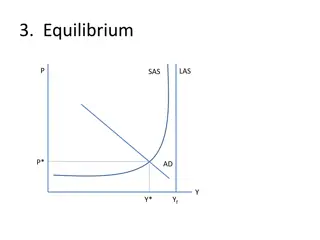Understanding Aggregate Supply in the Short and Long Run
Aggregate Supply in the short and long run is crucial in understanding the relationship between the economy's price level and the total quantity of goods and services produced. In the short run, sticky wages and production costs play key roles in determining supply levels, while in the long run, changes in production costs lead to shifts in the Aggregate Supply curve. Factors such as commodity prices, resources, nominal wages, and productivity all affect the Aggregate Supply, influencing economic output and prices.
Download Presentation

Please find below an Image/Link to download the presentation.
The content on the website is provided AS IS for your information and personal use only. It may not be sold, licensed, or shared on other websites without obtaining consent from the author. Download presentation by click this link. If you encounter any issues during the download, it is possible that the publisher has removed the file from their server.
E N D
Presentation Transcript
Aggregate Supply in the Short and Long Run
Short-run Aggregate Supply (SRAS) SRAS shows the relationship between the economy s aggregate price level and the total quantity of final goods and services (aggregate output or RGDP) producers are willing to supply. There is a positive relationship between price level and aggregate output (RGDP) A higher price level translates into a higher profit per unit of output Profit per unit of output is found by subtracting cost per unit from price per unit
SHORT-RUN AGGREGATE SUPPLY A higher price level increases profits and output moving the economy from a1 to a2 AS1 P2 a2 Price Level P1 a1 o Q1 Q2 Real domestic output
SHORT-RUN AGGREGATE SUPPLY A lower price level decreases profits and output moving the economy from a1 to a3 AS1 P2 a2 Price Level P1 a1 P3 a3 o Q3 Q1 Q2 Real domestic output
Short-Run Aggregate Supply In the short run production costs for a producer do not change Sticky wages: because wages do not rise as rapidly as price levels, producers receive extra profit in the short run and therefore produce more. In the long run production costs do change. These changes result in a shift of the Aggregate Supply (AS) curve
Changes (shifts) in Short Run AS AS changes (shifts) when per unit production costs change for reasons other than a change in output. If costs increase then AS shifts left. If costs decrease AS shifts right There are three determinants of AS. Commodity prices Domestic resources foreign resources (oil / exchange rates)
Changes in Short Run AS Nominal Wages Nominal wages are fixed in the short-run, but as time passes wage contracts are renegotiated to account for increases in inflation An increase in wages increases per unit production costs and shifts AS leftward Productivity* Technology *Productivity is measured by real output divided by input. An increase in productivity lowers per unit production costs and the shifts the curve rightward.
AGGREGATE SUPPLY in the SHORT-RUN AND LONG-RUN Short Run - Period in which nominal wages (and other input prices) remain fixed as the price level increases or decreases Long Run - Period in which nominal wages and other input prices are fully responsive to previous changes in the price level
SHORT RUN TO LONG RUN AGGREGATE SUPPLY A higher price level results in higher nominal wages and thus shifts the short-run aggregate supply to the left AS2 b1 AS1 a2 P2 Price Level a1 P1 o Q1 Q2 Real domestic output
SHORT RUN TO LONG RUN AGGREGATE SUPPLY A lower price level results reduces nominal wages and shifts the short-run aggregate supply to the right ASLR AS2 b1 AS1 a2 AS3 P2 Price Level a1 P1 P3 a3 c1 o Q3 Q1 Q2 Real domestic output
The Long-Run Aggregate Supply Curve In the long-run, an economy s production of goods and services depends on its supplies of labor, capital, and natural resources and on the available technology used to turn these factors of production into goods and services. The price level does not affect these variables. To illustrate this point the long- run AS is vertical.
The Long-Run Aggregate- Supply Curve... Price Level Long-run aggregate supply P1 2. does not affect the quantity of goods and services supplied in the long run. P2 1. A change in the price level 0 Natural rate of output Quantity of Output
LRAS and the Production Possibilities Curve The Long Run AS curve and the production possibilities curve represent the same thing: what is this economy capable of producing when fully employing all available resources and technology. They both can also illustrate that we may be operating in the short-run above or below our full-employment level. An economy is operating at the full employment level only if it is on the PPC or if AD/AS intersects on the LRAS.
Short run Equilibrium Above and Below Full Employment Price Level LRAS SRAS PL2 PL1 PL3 Q3 FE Q2 RGDP
Why the Short-run Aggregate Supply Curve Might Shift Shifts arising from a change in Labor costs. Shifts arising from a change in Capital costs. Shifts arising from a change in Natural Resource costs. Shifts arising from a change in Technology. Shifts arising from a change in the Expected Price Level.
Short Run to Long Run Aggregate Supply When people expect an increase in price levels they tend to set wages high. This shifts the short-run aggregate supply curve to the left. When people expect a decrease in price levels they tend to set wages low. This shifts the short-run aggregate supply curve to the right. These shifts bring short-run changes in output back to the long-run level.























